Production of Champagne and other Traditional Method Sparkling Wines
In Champagne, growers make as much as possible as the climate is so precarious. As much as one-third of grapes go unpicked every year, due to damage from spring frosts and fungal disease. The soil is infertile, causing the roots to penetrate downwards as far as 40 meters (130 feet). The majority of land needs to be aerated, and much still done by horse and plow. In the last decade, several wineries have become biodynamic, which has been proven to increase ripeness, while also increasing acidity and salty minerality.
The grapes
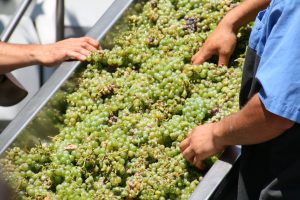 To make a quality wine, grapes should be picked by hand. Choice berries should have low potential alcohol and lack strong varietal character. Achieving this is often a problem in the New World, or with more aromatic varietals. Grapes are picked and pressed in whole bunches to minimize pigment from the skins, especially from Pinot Noir and Meunier. In Champagne, 78% is made by large houses, with the top five accounting for one-third of production. Most wineries purchase fruit from multiple vineyards. In other countries, grapes are more likely to come from one vineyard owned by the producer. Must is Chaptalized (sugar added) in Champagne, using concentrated grape juice.
To make a quality wine, grapes should be picked by hand. Choice berries should have low potential alcohol and lack strong varietal character. Achieving this is often a problem in the New World, or with more aromatic varietals. Grapes are picked and pressed in whole bunches to minimize pigment from the skins, especially from Pinot Noir and Meunier. In Champagne, 78% is made by large houses, with the top five accounting for one-third of production. Most wineries purchase fruit from multiple vineyards. In other countries, grapes are more likely to come from one vineyard owned by the producer. Must is Chaptalized (sugar added) in Champagne, using concentrated grape juice.
Pressing (wine)
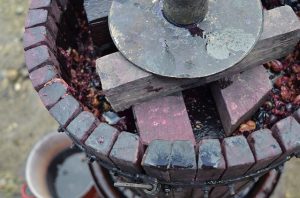 Pressing is done in 4 tonne lots. Only the first 2550 liters may be used in Champagne. It averages to 10,000 bottles per hectare (4,000 per acre). Many still use the traditional Coquard press, invented in the 17th century. It is a flat basket press, more wide than deep. Pressing is very gentle for low varietal flavor. Other producers favor the more modern bladder press. The first juice to come out is called the Cuvee and is the purest, with high acidity and low phenolics. Coeur de Cuvee is in the middle of the press and is considered the best. Later pressings, called the Tailles, have more astringency and pigment and are considered lower quality. This coarser juice is used sparingly, and not all in Prestige Cuvees. After pressing, the wine undergoes debourbages, or a settling of the solids.
Pressing is done in 4 tonne lots. Only the first 2550 liters may be used in Champagne. It averages to 10,000 bottles per hectare (4,000 per acre). Many still use the traditional Coquard press, invented in the 17th century. It is a flat basket press, more wide than deep. Pressing is very gentle for low varietal flavor. Other producers favor the more modern bladder press. The first juice to come out is called the Cuvee and is the purest, with high acidity and low phenolics. Coeur de Cuvee is in the middle of the press and is considered the best. Later pressings, called the Tailles, have more astringency and pigment and are considered lower quality. This coarser juice is used sparingly, and not all in Prestige Cuvees. After pressing, the wine undergoes debourbages, or a settling of the solids.
Fermentation
Primary fermentation most often takes place in stainless steel tanks, although other options are available. Some prefer oak vats or concrete eggs, but more wines are made in traditional oak barrels. For example; Krug ages its wines in new oak, while Bollinger prefers 110-year-old casks, adding oxidative and spicy old barrel aromas. However, too much oak overshadows the delicate nuances of Champagne, so the winemaker must be careful. Some use cultured (manmade) yeasts, but the trend is to use ambient (naturally occurring) yeasts. A warm short primary fermentation is typical so there is little fruitiness. The wine is then put through malolactic fermentation to soften acids. Wines age and settle for about four to six months, with options for oak or lees stirring if desired.
In 2000, Rose accounted for 3% of total production in Champagne. A gain in popularity pushed this figure up to 10% by 2015. The color in Rose is achieved three ways:
- A small amount (5-10%) of still red wine is added in,
- Saignee is free run from just pressed red grapes (best quality), or
- A limited maceration, although this makes darker heavier wines.
Many steps are geared toward losing acidity; yeast, Chaptalization, dosage, blending and aging.
Minerality is very important to the taste of Champagne, with the best wines displaying ocean flavors of sea salt and oyster shell. No one knows how the soil is able to transfer its flavors into the wine, but it makes the wines of Champagne unique.
Assemblage
Assemblage can involve hundreds of different base wines, and each house has its own style. Chardonnay is steely and fresh in youth but can age the longest. It acts as the skeleton of the cuvee. Pinot Noir adds complexity, structure, and body. Pinot Meunier is flowery and fruity, but lacks firmness and does not age well. One can say that Pinot Meunier is immediately appealing, Pinot Noir after a couple of years, then Chardonnay after five. Assemblage involves blending Reserve wines to the current year. These older wines are blended to add mellowness and complexity. They are stored in stainless tanks, oak or even magnums until needed. Some bad harvests are saved as Reserve wines to spread it out. For Vintage wines, you must reserve 20% for other wines.
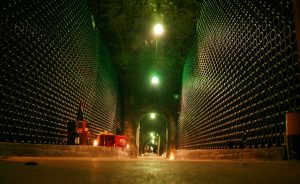
The assembled wine sits for a day or two to throw sediment, before beginning second fermentation. The yeasts for this are cultured and made specifically for this, as they can survive pressure and low temperatures. The yeast is mixed into a Liqueur de Tirage, also containing assembled wine, sugar, yeast nutrients and bentonite. The amount of sugar will affect how sparkling the wine is. The tirage generally has 24g/l of sugar to get 1.2 – 1.3% of additional alcohol. The bottles are then sealed with a crown cap, so that the Carbon Dioxide formed from fermentation cannot escape and becomes carbonation. There are different styles of crown caps, and the winemaker can decide how much oxygen gets through. This second fermentation is called Prise de Mousse, which means “capturing the sparkle.” This fermentation is cool (usually under 54 degrees (12C)) for 10 days to 3 months. 5-6 atmospheres of pressure and about 1.5% alcohol is created in the process. The slower and colder the 2nd fermentation, the more complex the wine will be. Larger bottles ferment slower, giving better quality to the finished wine. Small bottles are inferior.
Autolysis (wine)
Most quality sparkling is then stored horizontally to spread the yeast out so it can react with the wine. Bottles are stacked into space saving piles called lattes and left for months of years, although cheaper wines will skip this stage. The dead yeast cells will slowly decompose, releasing flavors of nuts, toast, bread and brandy, while building the body and mouthfeel. This is known as autolysis. It is mandatory in Champagne for 12 months, with a further 3 months aging in the bottle, for a total of 15 months. Most other countries require 9 months. Neither is enough time to give the flavors associated with autolysis, which become prominent at 18 months. After four years, not as much flavor is given off.
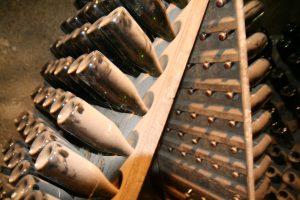 Once the bottles have received their proper aging, they are riddled either in pupitres (4 to 6 weeks) or gyro-palates (3 to 4 days). The purpose is to migrate the sediment from the side of the bottle to the neck. This needs to be done gently, otherwise yeasts stay suspended in the wine. As the win ages, the yeast will collect in a rubber ring inside the cap called the bidule. Once this has happened the wine will be ready for disgorgement.
Once the bottles have received their proper aging, they are riddled either in pupitres (4 to 6 weeks) or gyro-palates (3 to 4 days). The purpose is to migrate the sediment from the side of the bottle to the neck. This needs to be done gently, otherwise yeasts stay suspended in the wine. As the win ages, the yeast will collect in a rubber ring inside the cap called the bidule. Once this has happened the wine will be ready for disgorgement.
This involved placing the upside-down bottles into a conveyer belt, and passing the neck through a very cold brine solution. The wine in the neck is then frozen and the crown cap removed. The pressure from the 2nd fermentation will push out the block of ice. Today, this is done by machines, which are more safe, fast and accurate. A few wineries still disgorge by hand, called a la volle. To replace the lost wine, a liqueur de expedition is added. This is made of wine and usually a small amount of sugar, unless the wine is Brut Nature. Wines with higher acidity need more sugar, while later disgorged bottles need less. The liqueur de expedition can also contain oaky base wine, current wine, very old wine, and even brandy. These are the last adjustments that the winemaker can do before being sealed with a mushroom cork.
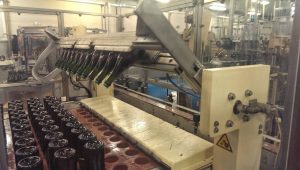 Many quality wines are further aged in the cellar after disgorgement. This rids the wine of unwanted acacia and candle-wax aromas. Before disgorgement, the wine is protected from oxygen by the lees. However afterwards, the wine will age differently. It will develop toasty, biscuit aromas from reacting with the air in the bottle in what is known as the Maillard process. For example, a 10-year-old bottle with 9 years on lees will taste much fresher and younger than a 10-year bottle with 2 years on lees.
Many quality wines are further aged in the cellar after disgorgement. This rids the wine of unwanted acacia and candle-wax aromas. Before disgorgement, the wine is protected from oxygen by the lees. However afterwards, the wine will age differently. It will develop toasty, biscuit aromas from reacting with the air in the bottle in what is known as the Maillard process. For example, a 10-year-old bottle with 9 years on lees will taste much fresher and younger than a 10-year bottle with 2 years on lees.
Other Means of Sparkling Production
Producing sparkling wine by the Traditional Method is difficult, costly and time consuming. This has led to alternative methods of obtaining sparkle, either by shortcuts or simplification.
Transfer Method – This process begins similar to the traditional method until secondary fermentation is complete, then transitions into the tank method. At this point, the already carbonated wine is moved to a tank for filtering. Meanwhile, the now empty bottles are cleaned. The bottles are then refilled and readied for sale. The transfer method saves money as takes away the need for riddling and individual disgorgement. The hybrid style of production is considered second best to the traditional method and used mostly in the new world, especially Australia.
Tank Method (Charmat, Cuvee Close, Martinotti) – This is a popular method for producing sparkling wine that saves time and money, although the wine will not be as complex. Wine is placed in a large tank for blending, and the liqueur de tirage is added. It then undergoes secondary fermentation in the tank, which is designed to withstand the pressure. The wine can be left on the lees for autolysis if the winemaker wants to recreate the profile of Champagne. It is then filtered; the dosage is added and finally bottled. The tank method is good for aromatic varieties like Riesling or Muscat. Italian Sparkling wines such as Prosecco or Lambrusco are also made this way.
Carbonation – Carbon dioxide gas is pumped into the finished wine similar to a soft drink. The bubbles are a lot larger and shorter lived. This is the cheapest way to add fizz. The lowest quality sparkling wines are made this way.
Méthode Ancestrale -There is no secondary fermentation, just a continuation of the first. Wines are fermented in stainless steel tanks, and transferred to bottles when only partially fermented at 4-5% alcohol. The first fermentation finishes inside the bottle, bringing the alcoholic strength up to 5-6%. Wines produced this way are usually sweet; with a minimum potential alcohol of 10%, and 3 bars of pressure. Because there is no disgorgement, yeast is present and causes the wine to be cloudy. This is a very old style of making sparkling, and wines taste like ripe apples with a soft sweet finish. A couple examples of this type of wine are Blanquette de Limoux Méthode Ancestrale and Clairette de Die Méthode Dioise Ancestrale
Types of Sparkling Wine
Non-Vintage: In Champagne, there are years when grapes didn’t ripen or were damaged by weather. By blending two or more years together, producers could hide the off-years while making a more consistent product. Non-Vintage accounts for 80-90% of output in Champagne. 15% of each year’s harvest must be added by law. Adding reserve (older) wines makes the Champagne more complex and mature. Tattinger (light and fruity style) uses 5-10% reserve, while Krug uses 40-50% for evolved style. These wines benefit from a year or two of cellaring. Most new world countries do not make a non-vintage because weather is usually favorable.
Vintage: Vintage must be 100% from the year. A few houses in Champagne only release them on good years, but many make a Vintage every year. Other producers have stopped making it altogether. Vintage wines are meant to be an exaggeration of that year. Wines must be aged for 3 years before being released. This gives them more autolytic (acacia) flavors, developing into bready or nutty flavors with several years aging. Vintage falls between Non-Vintage and the top Prestige Cuvees.
Prestige Cuvee: Made from the best wines with great capacity for aging. Selection is most important here, as Prestige cuvees are often exaggerations of winemaker style. The first was Cuvee Dom Perignon, invented after the 2nd World War. Today, 95% of top Prestige Cuvees (Cristal, Salon, Clos de Goisses, etc), are drunk before their optimal time. This has led some Champagneries (Comtes de Champagne, Blanc de Millenaires) to release their prestige cuvees when they are primed to drink.
Blanc de Blanc: It is the most common type of sparkling wine found around the world. Blanc de Blanc is usually the leanest, lightest and most elegant in the lineup, but it sometimes lacks fruit in youth. In Champagne, it must be from Chardonnay but doesn’t necessarily need to be sparkling. They can come from anywhere in Champagne but the best come from the Cote de Blancs. Other countries use any suitable white grape.
Blanc de Noir: The next most popular cuvee, most Blanc de Noir is fleshy and muscular, but lacks aging potential and finesse. In Champagne, they must be made from either Pinot Noir or Meunier, or a blend of the two. It typically lacks any color. In California Blanc de Noir is typically rosé colored.
Rosé: Champagne is the only region in the EU that allows red wine to be blended into white wine to make Rosé. Some are made by maceration, the greatest being Laurent-Perrier. Most have less acidity and show better earlier
Crémant: The term Cremant is used to designate sparkling wines made by the traditional method but falling outside the boundaries of Champagne. There are nine regions allowed to use the name. They are Alsace, Bordeaux, Borgogne, Die, Jura, Limoux, Loire, Savoie and Luxemburg. They often have a lower pressure (3.6 atmospheres instead of 5 or 6 for brut). A Mousse should unfold slowly, creating a cream on top.
Brut Nature (non-dosé): These wines are the driest and most transparent as no Liqueur de Expedition is added, however many lack generosity and are austere. This style has been gaining in popularity.
Red: Red sparkling is illegal in Champagne, but some wineries make a dark rosé. Australian Sparkling Shiraz or Italian Lambrusco are the most famous versions.
Aromatic styles: These do not exist in Champagne, but other countries make sparkling wine from aromatic varieties. The most famous are German Riesling Sekt, and Asti made from the Moscato Bianco grape. Keeping aromatic grapes on the yeast can be detrimental as they compete for aromas and flavors. As a result, these wines are made by tank method and disgorged as quickly as possible. Aromatic wines should smell like peaches and orange, but can develop an unpleasant geranium smell.
Pressure:
Sparkling wines can also be categorized by pressure. One atmosphere is 15 pounds per square inch. Sparkling wine can be up to 6 atmospheres, or 90psi, the same as a truck tire.
Mousseaux (Espumante, Spumante, Espumoso, Sparkling): 3.5 to 6 atmospheres
Crémant: This means slightly less sparkling, with wines between 3.5 and 4 atmospheres. The word originated in Champagne, but they agreed to stop using it in return for other regions not using Méthod Champenoise.
Pétillant (Frizzante, Semi-Sparkling, Spritzig): Wines with a lower pressure of 2.5 to 3.5 atmospheres. Pétillant wines are seen in the Loire or Piemonte.
Perlant (Frizzantino, Perlé, Perlwein, Prickle, Vino de Aguja): These wines are hardly sparkling at all, with less than 2.5 atmospheres. Inexpensive wines are often made in this style to avoid tax and higher rate of duty.
Sweetness Levels – There are not many sweet wines in Champagne as the style is no longer popular. The producer Doyard makes a 65 gram per liter wine, while Roederer’s Carte Blanche is 45 g/l.
Brut Nature 0-2 grams per liter
Extra Brut 0-6
Brut 0-12
Extra-Sec 12-17
Sec 17-32
Demi-Sec 33-50*
Doux >50 grams per liter*
Types of Producer (Champagne only) – Initials on the label signify who made the wine:
NM : Négociant-Manipulant – Champagne that was bottled by a large Negoicant, House or Firm, and made from purchased grapes. There may or may not be estate fruit in the blend.
RM : Récoltant-Manipulant – The initials RM indicate a grower is using their own grapes to make Champagne. They are allowed to buy and vinify other producers’ crop, but only to a maximum of 5% of their total production. These wines are normally from small estates and their product is considered to be more reflective of the terroir where the grapes have been grown. Some believe them to offer higher values for the price compared to the big houses, but this is debatable. Furthermore, some of them reach cult status making them quite rare on the market (e.g. Jacques Selosse).
CM : Cooperative-Manipulant – Champagne made and sold by a cooperative of growers and sold under their own labels.
RC : Récoltânt-Coopérateur – A grower selling wine made by cooperative . RC wines are becoming increasingly rare.
SR : Société de Récoltants – Wine produced by a small family company (such as two brothers). These wines are very rare
MA : Marque d’Acheteur – Indicating a sellers own brand, these wines could be a Supermarket brand or a private label made for a restaurant.

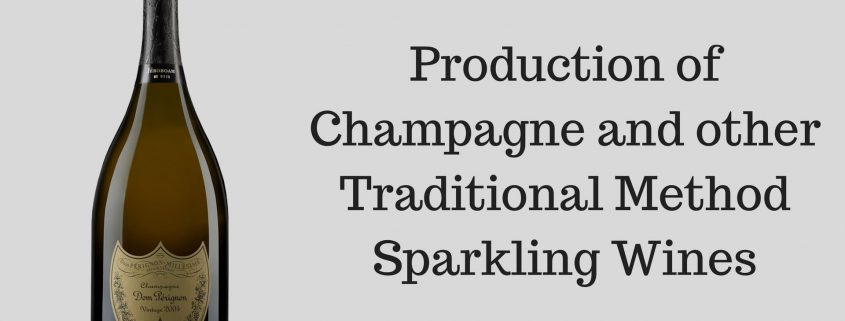
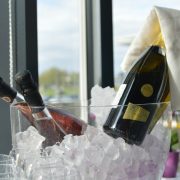
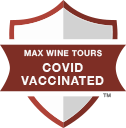 MWT Vaccinated
MWT Vaccinated

